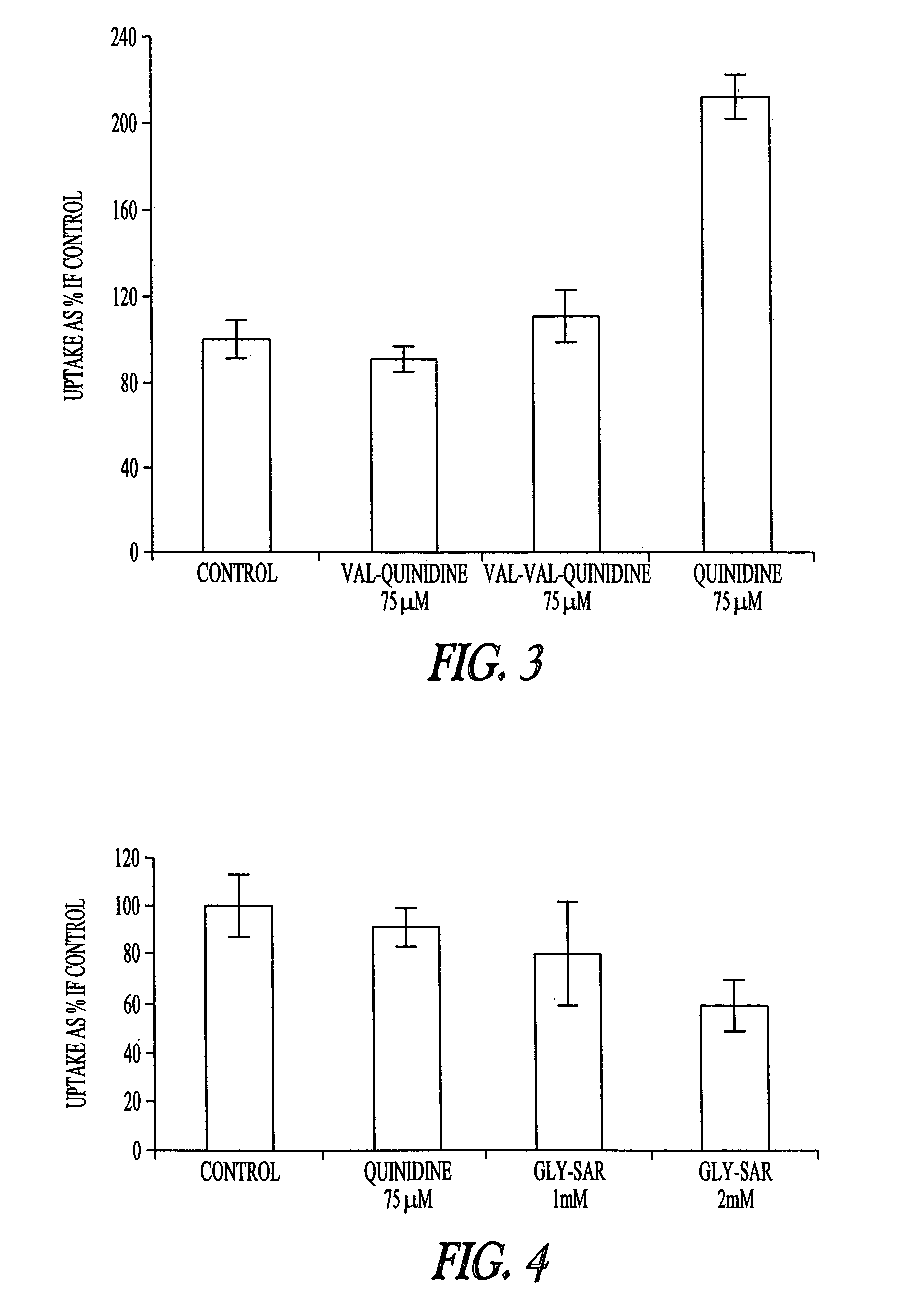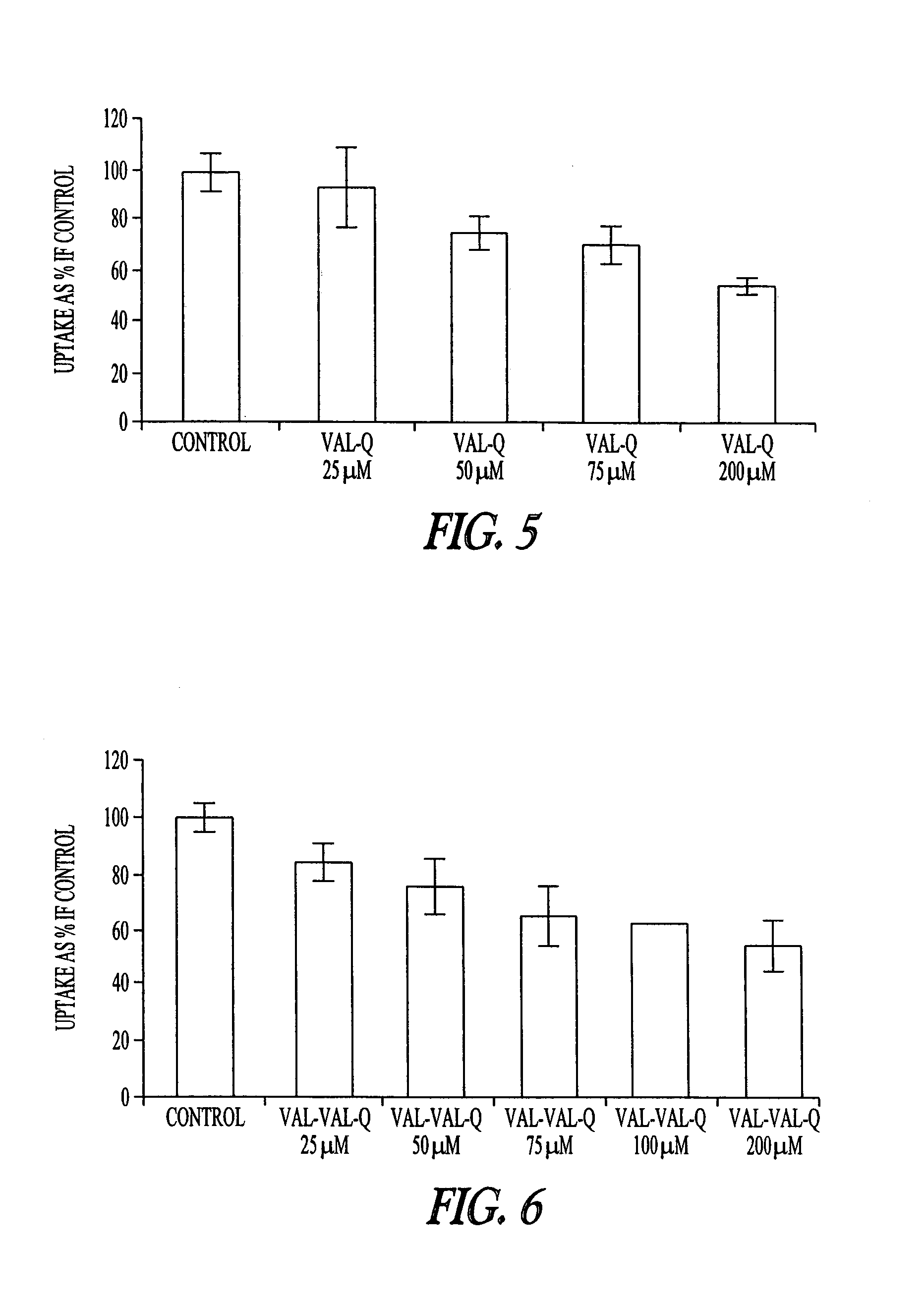Peptidyl prodrugs that resist P-glycoprotein mediated drug efflux
a technology of p-glycoprotein and prodrugs, applied in the direction of peptide/protein ingredients, drug compositions, bulk chemical production, etc., can solve the problems of limited bioavailability of various drugs which are p-gp substrates, major challenge in the treatment of various brain diseases, and limited use of these compounds, so as to improve the internalization of compounds and reduce the microsomal metabolism of free bioactive agents (drugs). , the effect of reducing the binding
- Summary
- Abstract
- Description
- Claims
- Application Information
AI Technical Summary
Benefits of technology
Problems solved by technology
Method used
Image
Examples
example 1
Synthesis of Val-Quinidine
[0103]Boc-Val-OH (2.00 g., 9.26 mmol) and DCC (1.90 g, 9.26 mmol) were dissolved in dry DMF (20 ml) under a nitrogen atmosphere. The mixture was stirred continuously for one hour at 0° C. A solution of quinidine (1.50 g, m4.63 mmol)) and DMAP (0.06 g, −0.65 mmol) in DMF (100 ml) was added dropwise to the reaction mixture at 0° C. The reaction mixture was stirred and allowed to warm to room temperature. After 24 hours, the reaction was checked by TLC (1:13 methanol / dichloromethane mixture) and LC-MS analysis, and was found to be complete. The urea derivative was removed by filtration and washed with ethyl acetate. Solvents from the combined filtrate and washing were totally removed under reduced pressure.
[0104]The resulting oil was dissolved in ethyl acetate and washed three times with a 5% NaHCO3 solution. Each time, the organic layer was separated and the combined layers were dried over anhydrous magnesium sulfate. Ethyl acetate was rotary evaporated at 40...
example 2
Synthesis of Amino Acid and Dipeptide Derivatives of Saquinavir
[0106]The general method to synthesize saquinavir derivatives according to the present invention is to conjugate the ligand with the hydroxyl group on saquinavir. The carboxylic group of the amino acid or peptide can form the ester link with saquinavir. Such modification may improve the delivery of saquinavir by targeting the amino acid transporter. Derivatives of other P-gp substrates bearing a hydroxyl group may be prepared analogously. In brief, the synthetic scheme includes i) formation the amino acid anhydrides, ii) coupling the anhydride with saquinavir, iii) removing the N-protection group, iv) neutralizing the conjugate, v) coupling the conjugate with an amino acid anhydride to form the peptide bond, and vi) removing the N-protection group. The overall procedure is shown in Scheme 1. Tri- and tetra-peptide analogs may be prepared analogously. The synthesis of Val-saquinavir 4 includes the first three steps with D...
example 3
MDCKII-MDR1 Cell Culture
[0113]MDCK cells, retrovirally transfected with human MDR1 cDNA were obtained as a gift from Dr. Piet Borst (Netherlands Cancer Institute, Amsterdam). These MDCKII-MDR1 cells (passages 4–10) were cultured at 37° C. in a humidified atmosphere with 5% CO2. Confluency was assessed by light microscopy. Cells were passaged at 70–80% confluence using 0.25% trypsin EDTA and were seeded at a density of 50,000 cells / cm2 on 12-well tissue culture plates or on collagen coated Transwell® inserts and were maintained in DMEM, supplemented with 10% calf serum, 100 IU / mL penicillin, 100 μg / mL streptomycin, 1% (v / v) non-essential amino acid, 3.7 g of sodium bicarbonate and 10 mM HEPES, pH 7.4. Cells were allowed to grow for 5–8 days. Integrity of monolayers formed on transwell was evaluated by monitoring [14C]mannitol permeability and transepithelial electric resistance (TEER), with an epithelial volt ohmmeter (EVOM; World Precision Instruments, Sarasota, Fla.). TEER values o...
PUM
| Property | Measurement | Unit |
|---|---|---|
| temperature | aaaaa | aaaaa |
| density | aaaaa | aaaaa |
| concentration | aaaaa | aaaaa |
Abstract
Description
Claims
Application Information
 Login to View More
Login to View More - R&D
- Intellectual Property
- Life Sciences
- Materials
- Tech Scout
- Unparalleled Data Quality
- Higher Quality Content
- 60% Fewer Hallucinations
Browse by: Latest US Patents, China's latest patents, Technical Efficacy Thesaurus, Application Domain, Technology Topic, Popular Technical Reports.
© 2025 PatSnap. All rights reserved.Legal|Privacy policy|Modern Slavery Act Transparency Statement|Sitemap|About US| Contact US: help@patsnap.com



